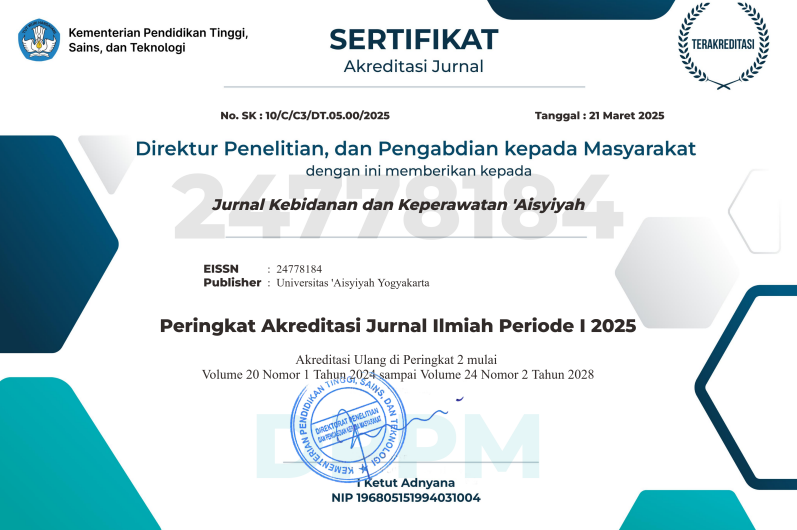Rancangan couple prenatal class dalam edukasi perawatan bayi baru lahir
DOI:
https://doi.org/10.31101/jkk.2792Abstract views 953 times
Keywords:
couple prenatal class, perawatan bayi baru lahir, rancanganAbstract
Downloads
References
Arista, B. E., Hadi, S., & Soesilaningtyas. (2021). Systematic Literature Review : Penggunaan Media Yang Efektif Dalam Promosi Kesehatan Gigi Dan Mulut Pada Anak Sekolah Dasar. Jurnal Ilmiah Keperawatan Gigi (JIKG), 2(2), 209–215.
Astiti, N. K. E., & Purnamayanti, N. M. D. (2022). Identification of the Needs Couples Against Prenatal Class Program in Badung Regency. Jurnal Ners Dan Kebidanan Indonesia) (Indonesian Jurnal of Nursing and Midwifery, 10(1), 36–47.
Darwin, Z., Galdas, P., Hinchliff, S., Littlewood, E., McMillan, D., McGowan, L., & Gilbody, S. (2017). Fathers’ views and experiences of their own mental health during pregnancy and the first postnatal year: A qualitative interview study of men participating in the UK Born and Bred in Yorkshire (BaBY) cohort. BMC Pregnancy and Childbirth, 17(1), 1–15. https://doi.org/10.1186/s12884-017-1229-4
Dayton, C. J., Brown, S., Goletz, J., Hicks, L., Barron, C., Sperlich, M., & Smith-Darden, J. (2019). Pathways to Parenting: Predictors of Prenatal Bonding in a Sample of Expectant Mothers and Fathers Exposed to Contextual Risk. Journal of Child and Family Studies, 28(4), 1134–1144. https://doi.org/10.1007/s10826-019-01343-6
Field, T. (2018). Postnatal anxiety prevalence, predictors and effects on development: A narrative review. Infant Behavior and Development, 51(February), 24–32. https://doi.org/10.1016/j.infbeh.2018.02.005
Fletcher, R., Silberberg, S., & Galloway, D. (2005). New Fathers’ Postbirth Views of Antenatal Classes: Satisfaction, Benefits, and Knowledge of Family Services. Journal of Perinatal Education, 13(3), 18–26. https://doi.org/10.1624/105812404x1734
Fuada, N., & Setyawati, B. (2015). Pelaksanaan Kelas Ibu Hamil di Indonesia. C Indonesian Journal of Reproductive Health.
Herbert, P. C., & Lohrmann, D. K. (2011). It’s All in the Delivery! An Analysis of Instructional Strategies From Effective Health Education Curricula. Journal of School Health, 81(5), 258–264.
Hiryanto. (2017). Pedagogi, Andragogi Dan Heutagogi Serta Implikasinya dalam Pemberdayaan Masyarakat. Dinamika Pendidikan, 22, 65–71.
Humaizi. (2018). Uses and Gratifications Theory. USU Press.
Indonesia, K. P. dan K. R. (2020). Standar Nasional Pendidikan Tinggi.
Kronborg, H., Harder, I., & Hall, E. O. C. (2015). First time mothers’ experiences of breastfeeding their newborn. Sexual and Reproductive Healthcare, 6(2), 82–87. https://doi.org/10.1016/j.srhc.2014.08.004
McDaniel, B. T., & Teti, D. M. (2012). Coparenting quality during the first three months after birth: The role of infant sleep quality. Journal of Family Psychology, 26(6), 886–895. https://doi.org/10.1037/a0030707
Mytton, J., Ingram, J., Manns, S., & Thomas, J. (2014). Facilitators and Barriers to Engagement in Parenting Programs: A Qualitative Systematic Review. Health Education and Behavior, 41(2), 127–137. https://doi.org/10.1177/1090198113485755
Parfitt, Y., & Ayers, S. (2014). Transition to parenthood and mental health in first-time parents. Infant Mental Health Journal, 35(3), 263–273. https://doi.org/10.1002/imhj.21443
RI, K. K. (2021). Pedoman Penyusunan Kurikulum dan Modul Pelatihan Bidang Kesehatan. Kementrian Kesehatan RI.
Sabarudin, Mahmudah, R., Ruslin, Aba, L., Nggawu, L. O., Syahbudin, Nirmala, F., Saputri, A. I., & Hasyim, M. S. (2020). Efektivitas Pemberian Edukasi secara Online melalui Media Video dan Leaflet terhadap Tingkat Pengetahuan Pencegahan Covid-19 di Kota Baubau. Jurnal Farmasi Galenika (Galenika Journal of Pharmacy) (e-Journal), 6(2), 309 – 318.
Soetjiningsih, & Ranuh, I. . G. (2013). Tumbuh Kembang Anak. EGC.
Sugiyono. (2019). Metode Penelitian Pendidikan: Kuantitatif, Kualitatif, Kombinasi, R&D dan Penelitian Pendidikan. Alfabeta.
Violetta, B. A. H. F., & Wongso, S. (2019). Desain Partisipatoris Dalam Perancangan Media Informasi Kesehatan Untuk POSYANDU Mekar Bakti. Prosiding Seminar Nasional Desain Sosial.
Wijaya, A. M. (2011). Kebutuhan-Dasar-Anak-Untuk-Tumbuh-Kembang-Yang-Optimal. https://kesmas.kemkes.go.id/konten/133/0/021113-kebutuhan-dasar-anak-untuk-tumbuh-kembang-yang-optimal
Winarni, L. M., Winarni, E., & Ikhlasiah, M. (2018). Pengaruh Dukungan Suami Dan Bounding Attachment Dengan Kondisi Psikologis Ibu Postpartum Di Rsud Kabupaten Tangerang Tahun 2017. Jurnal Ilmiah Bidan, 3(2), 1–11.
Downloads
Published
How to Cite
Issue
Section
License
With the receipt of the article by the Jurnal Kebidanan dan Keperawatan Aisyiyah Editorial Board and the decision to be published, then the copyright regarding the article will be diverted to Jurnal Kebidanan dan Keperawatan Aisyiyah. Universitas 'Aisyiyah Yogyakarta as the publisher of Jurnal Kebidanan dan Keperawatan Aisyiyah hold the copyright regarding all the published articles in this journal.
Jurnal Kebidanan dan Keperawatan Aisyiyah is licensed under a Creative Commons Attribution-ShareAlike 4.0 International License.
















